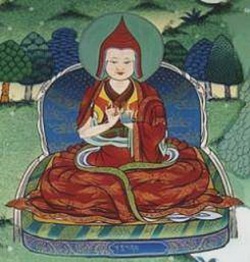Taranatha’s Travels in Mongolia by Michael Sheehy
There is an intriguing and somewhat mystifying narrative that has been popularized about the Tibetan Jonang master Taranatha (1575-1635). This narrative suggests an account of Taranatha’s life story in which he traveled to Mongolia from his seat at Takten Damchö Ling Monastery in Central Tibet during the latter part of his life and that while there, he established several monasteries before finally passing away in Ulan Bator, the capital city in the republic of the Mongols.
This narrative on Taranaha’s travels and death in Mongolia has become so popular and widely accepted as factual that it is often the standard account given on the web and is commonly found in publications. Yet considering its regular appearance in English language sources, it became apparent to me a few years ago while in conversation with a Jonang lama in Amdo about the life of Taranatha that this narrative was mostly unknown to contemporary Jonangpas in Tibet. So where did this narrative originate? Why? And what other narratives about the final days and death of Taranatha do we find in Jonang sources?
Well, those are complex historical questions with complex historical answers. Questions that are beyond this scope of this short blog post. For now, I want to simply point to a few excerpts and possible (and not possible) sources for the origins of this narrative as we know it.
One thing that we do know is that Taranatha was a prolific writer and orator. His autobiography is one of the best sources that we have for understanding this magnetic personality and the fascinating time in Tibetan history in which he lived. His autobiography of almost seven hundred pages was also meticulously written up to a few years before his death in 1635. Interestingly enough, his own account of his life does not mention travels to Mongolia, though he does meet with Mongolian visitors on numerous occasions and may have even received an invitation. However, as this narrative is usually told, he departed for Mongolia soon after the construction of Takten Damchö Ling Monastery. This would have been in the year 1615, according to his own autobiography. That would mean that he would of spent the last twenty years of his life in Mongolia, years that contradict his own account of his life during that time.
So if it’s not in his own life writings, then where does this narrative originate? Why has it gained such traction? At this stage in my research, it seems as though it could have originated in Mongolia sometime around the appointment of the 1st Kalkha Jetsun Dampa Rinpoche. What then becomes an interesting question for me is what are some of the local stories or lore associated with this narrative. For instance, I’ve heard that a pair of Taranatha’s boots are on display at a monastery in Mongolia, as proof of his visitation.
Assuming for a moment that this narrative did originate in Mongolia or is at least found in Mongolian historical texts (which I realize is potentially a dangerous idea), what then becomes problematic is our English version of the narrative. As far as I can tell, one of the first renditions of this narrative appears in English in the Lieutenant Colonel Laurence Austine Waddell’s book, The Buddhism of Tibet, or Lamaism that was first published in 1895. Waddell was one of the early explorers who traveled into Tibet secretly in disguise on several occasions, and then officially with the British Army during its invasion into southern Tibet led by Colonel Younghusband in 1903 and 1904. In this classic book on Tibet in which he recounts information from his conversations in Tibet and from a few texts that he collected, Waddell writes,
Taranattha, son of Nam-gyal Pün-tsogs, was born in Tsang on the 8th day of the pig-male-tree year, corresponding to 1573 A.D., and was called Kun-dgah sÑying-po, or The essence of happiness. He studied in the Jonang monastery, north of Sakya under the religious name of Taranatha, and in his forty-first year built himself a monastery in the neighborhood, which he named rTag-brten, and filled it with many images, books, and caityas. He latterly proceeded to Mongolia at the invitation of the people of that country, and founded there several monasteries under the auspices of the Chinese Emperor. He died in Mongolia, and was canonized under the title of The Reverend Holiness, Je-tsun dam-pa. And his re-incarnate successors are now installed with great magnificence as Grand L?mas at Urgya in the Kalkha province of Mongolia, to the east of Lob-Nor.
Waddell does not cite his source or give any indication from where he received this information. However, it’s known that Waddell spoke Tibetan and he presents this passage as if the information was received from a Tibetan informant, not a Mongolian. This suggests that it was either an oral account from someone he met during one of his trips to Tibet or that there is an actual passage that states this narrative in a Tibetan text (that he neglected to mention). To date, and the search goes on, I’ve not located a textual account in Tibetan language sources and I can pretty safely say that it’s not in any of the biographical or historical Jonang Tibetan literature.
Source
This also appears on the Jonangpa.com blog.
- Information about the Mongolian sources is based on email correspondences with Orna Uranchimeg Tsultem at the University of California, Berkeley. Many thanks to her.
